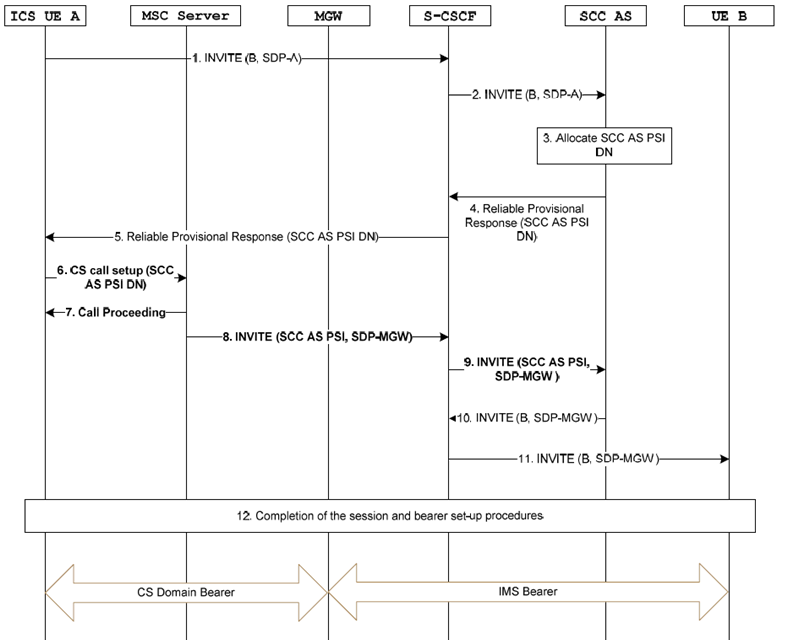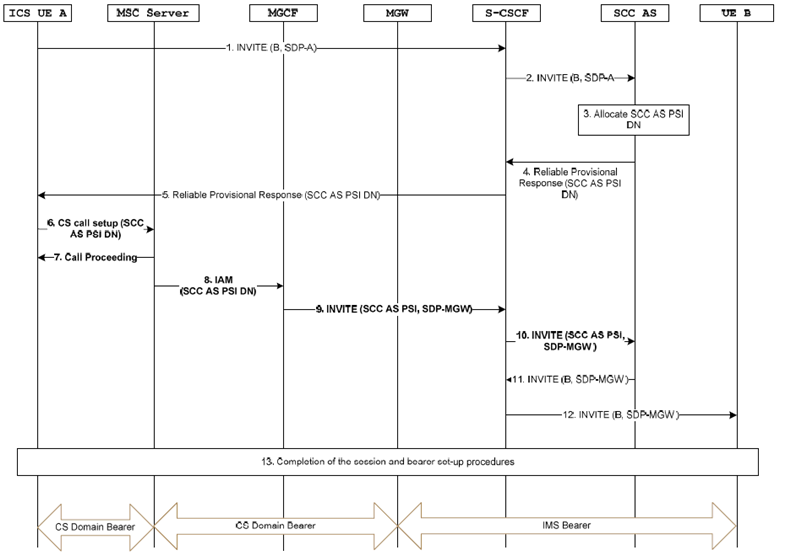Content for TS 23.292 Word version: 17.0.0
1…
4…
5…
7…
7.2…
7.3…
7.3.2.2…
7.3.2.2.4…
7.4…
7.4.2.2…
7.4.2.2.3…
7.4.2.2.7…
7.5…
7.6…
7.6.1.2.2.6…
7.6.1.2.3…
7.6.1.2.3.5…
7.6.1.2.3.6…
7.6.2…
7.6.2.7
7.6.2.8…
7.6.2.11…
7.6.3…
7.7…
7.7.2…
7.9…
7.9.2…
7.9.2.4
7.9.2.5
8…
A…
G…
H…
H.5…
H.5.3…
7.3.2.2.4 Originations with CS media using the Gm reference point
7.3.2.3 CS Emergency call interworking with IMS
...
...
7.3.2.2.4 Originations with CS media using the Gm reference point p. 39
Figure 7.3.2.2.4-1 provides an example flow for a session origination by an ICS UE attached to an MSC Server enhanced for ICS where the Gm reference point is used to set up the session with the CS media bearer.

Figure 7.3.2.2.4-1: ICS UE Origination with CS media using Gm reference point when using an MSC Server enhanced for ICS
(⇒ copy of original 3GPP image)
(⇒ copy of original 3GPP image)
Step 1.
Figure 7.3.2.2.4-2 provides an example flow for a session origination by an ICS UE attached to an MSC Server where the Gm reference point is used to set up the session with the CS media bearer.
The ICS UE A sets up a Service Control Signalling Path by initiating a standard IMS origination session towards the UE B. A SIP INVITE request (indicating the use of CS media for the session) is sent to the S-CSCF serving the UE A in the home IMS network.
Step 2.
The SCC AS is inserted in the IMS session path using originating initial filter criteria at the S-CSCF. The SCC AS is the first AS inserted in the session path.
Step 3.
The SCC AS allocates a PSI DN and sends it to the ICS UE A.
Step 4.
The SCC AS returns the SCC AS PSI DN in a reliable provisional response to the S-CSCF
Step 5.
The S-CSCF forwards the provisional response (containing the SCC AS PSI DN) to ICS UE A.
Step 6.
The ICS UE uses standard CS originating procedures to establish the CS Bearer Control Signalling Path with the SCC AS by sending a CS call setup message to the MSC Server containing the SCC AS PSI DN.
Step 7.
The MSC Server responds with a Call Proceeding message and begins to set up the CS Bearer Control Signalling Path.
Step 8.
The MSC Server sends an INVITE to the S-CSCF with the Request-URI set to the SCC AS PSI. If a GRUU is to be included as described in TS 23.228, then include a temporary-GRUU as the contact address if privacy has been requested or public-GRUU if privacy has not been requested. The MSC Server adds the User Location Information (e.g. CGI or SAI) and/or UE Time Zone Information to the INVITE.
Step 9.
The S-CSCF carries out standard processing of originating initial filter criteria and sends the INVITE to the SCC AS.
Step 10.
The SCC AS invokes a B2BUA, terminating the Access Leg and originating the Remote Leg for presentation of an IMS session towards the B-party on behalf of ICS UE A. The SCC AS correlates the CS bearer control signalling with the service control signalling and combines both the SDP offers into one offer towards the UE B. The SCC AS inserts the SDP received on the CS Bearer Control Signalling Path into the INVITE indicating CS media towards the B-party. The INVITE request is routed from the SCC AS to the S-CSCF.
Step 11.
The S-CSCF continues with standard IMS originated session processing and routes the request onwards to the B-party
Step 12.
Completion of the Service Control Signalling Path and the CS Bearer Control Signalling Path setup procedures. For video call, to complete the session and bearer setup, the specific handling as described in clause 7.3.2.2.1 applies.

Figure 7.3.2.2.4-2: ICS UE Origination with CS media using Gm reference point when using an MSC Server
(⇒ copy of original 3GPP image)
(⇒ copy of original 3GPP image)
Steps 1-7 in Figure 7.3.2.2.4-2 are identical to steps 1-7 in Figure 7.3.2.2.4-1.
At Steps 8 and 9, the MSC server sends the IAM using the SCC AS PSI DN to an MGCF which is subsequently inter-worked to an INVITE.
Steps 10-13 in Figure 7.3.2.2.4-2 are identical to steps 9-12 in Figure 7.3.2.2.4-1.
7.3.2.3 CS Emergency call interworking with IMS |R14| p. 42
If the MSC Server enhanced with ICS supports I6, it may perform the following procedure to interwork with IMS for handling CS emergency call to PSAP.
If the MSC Server detects a CS emergency call (i.e, due to CS setup with emergency indication or detection of locally defined emergency number) from an UE that has already been registered in this MSC Server using I2 registration procedure, then MSC Server shall perform a registration for the support of emergency services (emergency registration) to IMS via I2. The MSC Server then proceeds with emergency session establishment request to E-CSCF via I6.
If MSC Server is required to handle anonymous emergency call (i.e., based on local regulation), MSC Server shall not perform any registration procedure to IMS and shall directly proceed with anonymous emergency requests toward E-CSCF via I6.
If the MSC Server detects that the CS emergency call is tagged with eCall indication from the UE, MSC Server shall include the IMS eCall indication in the emergency session establishment request to E-CSCF via I6. The UE transfers the MSD using in-band modem as defined for CS eCall. The MSC Server and IMS shall transfer the MSD data in an end to end fashion, UE to PSAP, in the form generated by the UE.
For UE that has been registered to this MSC Server but IMS registration using I2 has not been performed then MSC Server shall fall back to the behaviour of an MSC Server that is not enhanced for ICS in handling CS emergency call.